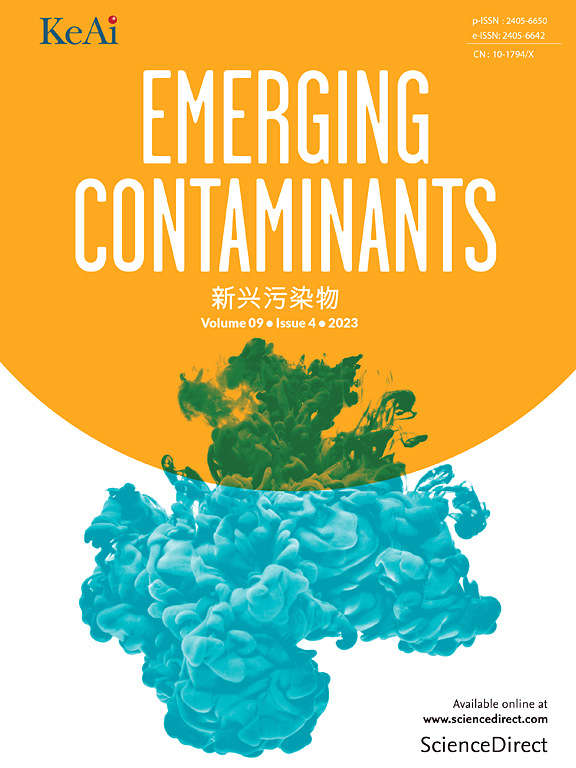评估南非各类水中全氟烷基和多氟烷基物质的污染和风险概况:过去十年的趋势(2014-2024年)
IF 6.9
2区 环境科学与生态学
Q1 ENVIRONMENTAL SCIENCES
引用次数: 0
摘要
本研究调查了2014-2024年期间南非水系统中全氟烷基和多氟烷基物质(PFAS)的发生、空间分布以及生态和人类健康风险。在缺乏直接饮用水数据的情况下,通过潜在作物灌溉进行了生态风险评估和间接人类暴露评估,使用了四个区域的地表水和废水中的PFAS浓度测量:北部(豪登省、林波波省、姆普马兰加省、西北部)、西部(北开普省)、东部(夸祖鲁-纳塔尔省、自由邦)和南部(东开普省和西开普省)。在所分析的化合物中,全氟辛酸(PFOA)最为普遍,浓度范围从东开普省的315纳克/升到瓦尔河(豪登省)的420纳克/升不等,其生态风险商(RQ)值分别为3.15和4.05,均超过RQ安全阈值1。全氟丁酸(PFBA)和全氟己酸(PFHxA)也具有中等生态风险,峰值浓度分别为380 ng/L(西部)和267 ng/L(北部),对应的RQ值为1.10-1.78。北部地区,特别是瓦尔河和哈特比斯波特大坝等地点,显示出最高的PFAS负担。PFOA和PFHxA之间有很强的相关性(r = 0.95),表明它们有共同的污染源。PFHxA (CV = 12.84%)比PFOA (CV = 9.92%)的空间变异更为明显。食用农作物对人类健康的间接风险可以忽略不计,危害商(HQ)值低于0.019,增量终身癌症风险(ILCR)估计低于2.70 × 10−8。尽管人类健康风险很小,但持续存在的生态威胁,特别是在北部地区,突出表明需要加强管理监督、长期监测和有针对性的PFAS治疗战略。本文章由计算机程序翻译,如有差异,请以英文原文为准。

Assessing contamination and risk profiles of per- and polyfluoroalkyl substances across various types of water in South Africa: trends over the past decade (2014–2024)
This study investigates the occurrence, spatial distribution, and ecological and human health risks of per- and polyfluoroalkyl substances (PFAS) in South African water systems over the period 2014–2024. In the absence of direct drinking water data, ecological risk assessments and indirect human exposure evaluations via potential crop irrigation were conducted using PFAS concentrations measured in surface water and wastewater across four regional zones: north (Gauteng, Limpopo, Mpumalanga, Northwest), west (Northern Cape), east (KwaZulu-Natal, Free State), and south (Eastern and Western Cape). Among the compounds analysed, perfluorooctanoic acid (PFOA) was the most prevalent, with concentrations ranging from 315 ng/L in the Eastern Cape to 420 ng/L in the Vaal River (Gauteng), yielding ecological risk quotient (RQ) values of 3.15 and 4.05, respectively, both exceeding the RQ safety threshold of 1. Perfluoro butanoic acid (PFBA) and perfluoro hexanoic acid (PFHxA) also presented moderate ecological risks, with peak concentrations of 380 ng/L (west) and 267 ng/L (north), corresponding to RQ values of 1.10–1.78. The north zone, particularly sites like the Vaal River and Hartbeespoort Dam, exhibited the highest PFAS burden. A strong correlation (r = 0.95) between PFOA and PFHxA suggests common sources of contamination. Spatial variability was more pronounced for PFHxA (CV = 12.84 %) than for PFOA (CV = 9.92 %). Indirect human health risks from crop ingestion were negligible, with hazard quotient (HQ) values below 0.019 and incremental lifetime cancer risk (ILCR) estimates below 2.70 × 10−8. Despite minimal human health risks, the persistent ecological threats particularly in the north zone underscore the need for enhanced regulatory oversight, long-term monitoring, and targeted PFAS treatment strategies.
求助全文
通过发布文献求助,成功后即可免费获取论文全文。
去求助
来源期刊

Emerging Contaminants
Medicine-Public Health, Environmental and Occupational Health
CiteScore
10.00
自引率
6.70%
发文量
35
审稿时长
44 days
期刊介绍:
Emerging Contaminants is an outlet for world-leading research addressing problems associated with environmental contamination caused by emerging contaminants and their solutions. Emerging contaminants are defined as chemicals that are not currently (or have been only recently) regulated and about which there exist concerns regarding their impact on human or ecological health. Examples of emerging contaminants include disinfection by-products, pharmaceutical and personal care products, persistent organic chemicals, and mercury etc. as well as their degradation products. We encourage papers addressing science that facilitates greater understanding of the nature, extent, and impacts of the presence of emerging contaminants in the environment; technology that exploits original principles to reduce and control their environmental presence; as well as the development, implementation and efficacy of national and international policies to protect human health and the environment from emerging contaminants.
 求助内容:
求助内容: 应助结果提醒方式:
应助结果提醒方式:


